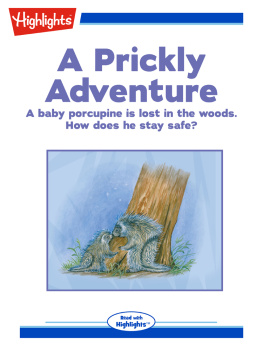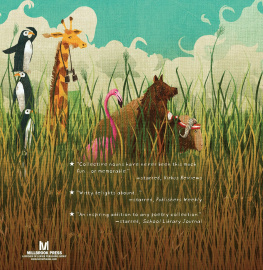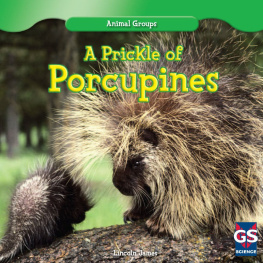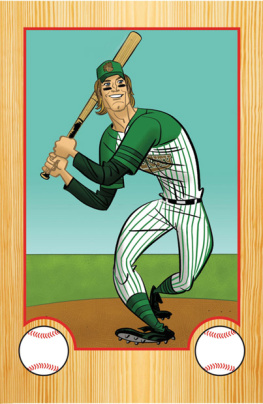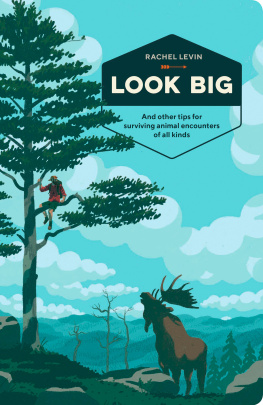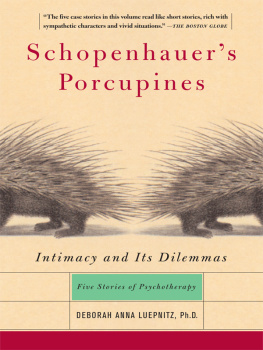Porcupines: The Animal Answer Guide
Porcupines
The Animal Answer Guide
Uldis Roze

2012 The Johns Hopkins University Press
All rights reserved. Published 2012
Printed in the United States of America on acid-free paper
9 8 7 6 5 4 3 2 1
The Johns Hopkins University Press
2715 North Charles Street
Baltimore, Maryland 21218-4363
www.press.jhu.edu
Library of Congress Cataloging-in-Publication Data
Roze, Uldis, 1938
Porcupines: the animal answer guide / Uldis Roze.
p. cm.
Includes bibliographical references and index.
ISBN 978-1-4214-0735-7 (hbk. : alk. paper) ISBN 1-4214-0735-3 (hbk. : alk. paper) ISBN 978-1-4214-0736-4 (pbk. : alk. paper) ISBN 1-4214-0736-1 (pbk. : alk. paper) ISBN 978-1-4214-0759-3 (electronic) ISBN 1-4214-0759-0 (electronic)
1. PorcupinesMiscellanea. I. Title.
QL737.R6R76 2012
599.3597dc23 2012008902
A catalog record for this book is available from the British Library.
Special discounts are available for bulk purchases of this book. For more information, please contact Special Sales at 410-516-6936 or.
The Johns Hopkins University Press uses environmentally friendly book materials, including recycled text paper that is composed of at least 30 percent post-consumer waste, whenever possible.
Friend porcupine, rumbled the hippo. I am worn out struggling with you while you dont have a quill out of place. You are stronger than you look. Let us be friends!
And forever after, the porcupine was happy to know that, despite his small size, the big animals respected him.
AFRICAN FOLK TALE
Contents
Acknowledgments
In preparing this work, I am greatly indebted to Louise Emmons, Research Associate in the Division of Mammals at the National Museum of Natural History, Smithsonian Institution, who read through two versions of the manuscript and gave invaluable help both with biological information and with style. For any remaining errors, I alone am responsible. However, a book like this requires the help of individuals across the world. I have encountered their support in the form of stimulating discussions, reading of sections of the manuscript, species identifications, providing rare photos and data, assistance with museum collections, and other acts of generosity.
In addition to an anonymous reviewer, three people read the manuscript in its entirety and contributed greatly to its development: my brother Maris Roze, former director of DeVry University Press; Wendolyn Tetlow, Vice President for Instruction at Bay College, Michigan; and Vincent Burke, Senior Science Editor at the Johns Hopkins University Press.
Thanks go to Peter Ahnelt, Rodrigo Alvarenga, India Amos, David Aurioles-Gamboa, Nancy Bareis, Barbara Bellens-Picon, Carlos Benfica, Dominique Berteaux, Barbara Blake, Ann Bryant, Rochelle Buffenstein, Eduardo Carvalho, David Chapman, Thomaz Chausson, Adriano Chiarello, Barbara Cole, Jessica Coltrane, Peter Cott, Arnaud L. J. Desbiez, Louis DeVos, Robert Dowler, Ariana Finkelstein, Francisco Fonturbel, Gaston Gine, Gislene Gonalves, Linda Gordon, Andrew Greller, David Hall, Roger Hassler, Virginia Hayssen, Diane Honer, Bill Hughes, Jean-Pierre Hugot, Matt Johnson, Howard Kaplan, Wighart von Koenigswald, Kathleen LaMattina, Rodrigo Lima, Mauro Lucherini, Darrin Lunde, Wayne Lynch, Jennifer Malat, Karen McElmurry, Philippa Moore, Mariana Muoz-Romo, Pedro Oliveira, Sam Palmer, Renata Pardini, Leo Peichl, Norman Perrin, Fei-Wen Pirovolikos, Alex Shoumatoff, Andrei Taranchenko, Richard Thorington, Robert Mark Timm, Rudi Van Aarde, Nelida Villaseor, Robert Voss, John Wahlert, and Samantha Yeltatzie.
These acts of generosity exemplify the traditions of the scientific community. In fact, it might be this tradition of cooperation that has been one of the driving forces of the worldwide scientific enterprise.
Introduction
My involvement with porcupines started with a single species: the North American porcupine. I have spent nights sleeping under a porcupine high above in its forest feeding tree, have hiked through mountain forests tracking far-flung individuals, and have lived through both triumphs and tragedies of individual animals, such as the frenzied reaction of a human-raised orphan to her first scent of a porcupine in the wild or the long vigil of an old mother by the body of her son, who had fallen out of his brittle-branched feeding tree and been killed instantly. Such experiences make one appreciate the porcupines as long-lived animals with intricate personal histories.
In my first study, in 1984, I followed the tracks of individual porcupines in the snow. The snow tracks testified to an admirable economy of movement: optimal choice of feeding trees, awareness of other porcupines and potential predators, understanding of the terrain. In short, the porcupines showed a beautiful adaptation to their environment and food supply.
A similar fineness of adaptation to environment and lifestyle emerges in this comparison of the biological adaptations of porcupine species across the world, most of whom never experience snow and may never feed on tree bark. These cross-comparisons highlight the creativity of the evolutionary process. The 26 known porcupine species follow 26 different ways of life, a feat made possible by small and large physiological and anatomical innovations. Thus, we can describe at least two designs of the retina, six different designs of the tail, and at least seven different quill designs. All these are offshoots of an ancestral body plan that originated in the Old World Eocene, more than 40 million years ago. By looking at such differences, we can better appreciate the uniqueness of each porcupine species living today.
The question and answer format of the book allows the reader to start at any point as interests dictate. This requires each discussion to stand on its own feet, so certain facts are repeated across sections. But in each case, the information appears in a different context of a large and complex story. To sort out a stream of possibly unfamiliar species names, you may refer to a porcupine whos who in .
In this book I have often felt like a speaker responding to questions from an erudite audience. Good questions can lead to insights that neither party anticipatedone definition of the scientific process. The questions can seem simple: What is a porcupine? What do porcupines eat? How do they survive the winter? Or the questions may have layers of complexity: What are the porcupines closest relatives? How do scientists tell porcupine species apart? How will global warming affect the porcupines? But one of the most important questions in this series is the last one: What dont we know about porcupines?
The amount we dont know about porcupines is staggering. This is partly because of the nocturnal, tropical-forest lifestyle of most porcupines of the world, but also because of the paucity of molecular biology studies of these animals and because their lifestyles have few parallels with other animal groups. These mysteries make porcupines a lure to scientists and nature lovers alike.
One of the great pleasures of working on this book has been the opportunity to explore these mysteries and discover aspects of porcupine life not known before. For instance, unlike all other New World porcupines, one South American species lacks one-way barbs on its defensive quills, leading to important differences in defense strategy (see ).
Still another surprise was that in all porcupines with multicolored quills, the lighter-colored portions fluoresce under a black light. They do so because they carry brighteners, which make the porcupines more visible in the dark (see ). These observations were made with simple tools that are available to many readers. Yet each illuminates a broader aspect of porcupine biology.
Next page

